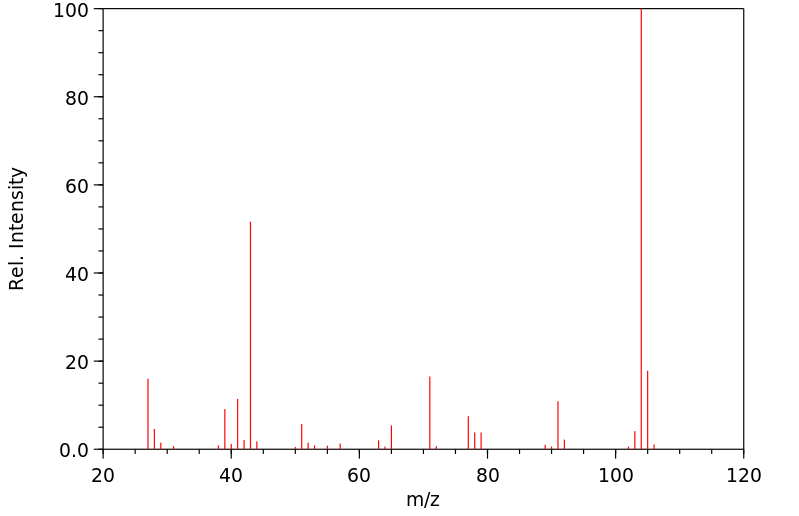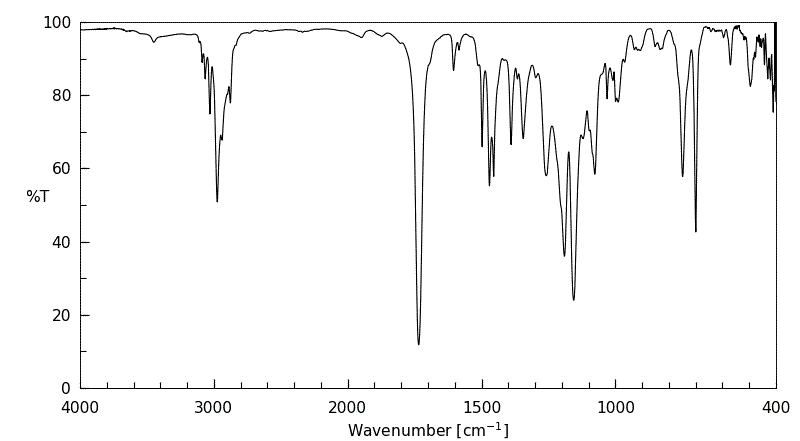异丁酸苯乙酯 | 103-48-0
中文名称
异丁酸苯乙酯
中文别名
异丁酸苄基甲酯;2-甲基丙酸苯乙酯;2-甲基-丙酸2-苯乙酯
英文名称
phenylethyl isobutyrate
英文别名
2-phenylethyl isobutyrate;2-phenylethyl 2-methylpropanoate;2-methyl-propanoic acid 2-phenylethyl ester;Phenethyl isobutyrate
CAS
103-48-0
化学式
C12H16O2
mdl
MFCD00026441
分子量
192.258
InChiKey
JDQVBGQWADMTAM-UHFFFAOYSA-N
BEILSTEIN
——
EINECS
——
-
物化性质
-
计算性质
-
ADMET
-
安全信息
-
SDS
-
制备方法与用途
-
上下游信息
-
文献信息
-
表征谱图
-
同类化合物
-
相关功能分类
-
相关结构分类
物化性质
-
沸点:250 °C (lit.)
-
密度:0.988 g/mL at 25 °C (lit.)
-
闪点:227 °F
-
溶解度:不溶于水
-
LogP:3.5 at 35℃
-
物理描述:Liquid
-
折光率:1.485-1.490
-
保留指数:1375;1400;1375;1375.3;1368;1371;1380.6;1374;1368
-
稳定性/保质期:
计算性质
-
辛醇/水分配系数(LogP):3.3
-
重原子数:14
-
可旋转键数:5
-
环数:1.0
-
sp3杂化的碳原子比例:0.416
-
拓扑面积:26.3
-
氢给体数:0
-
氢受体数:2
安全信息
-
安全说明:S24/25
-
WGK Germany:2
-
海关编码:2915600000
-
RTECS号:NQ5435000
-
危险性防范说明:P264,P280,P302+P352,P312,P337+P313,P305+P351+P338,P362+P364,P332+P313
-
危险性描述:H302+H312,H315,H319
-
储存条件:室温下密封保存,并保持干燥。
SDS
模块 1. 化学品
1.1 产品标识符
: 异丁酸苯乙酯
产品名称
1.2 鉴别的其他方法
无数据资料
1.3 有关的确定了的物质或混合物的用途和建议不适合的用途
仅用于研发。不作为药品、家庭或其它用途。
1.5 应急咨询电话
模块 2. 危险性概述
2.1 GHS危险性类别
非危险物质或混合物。
2.3 其它危害物 - 无
模块 3. 成分/组成信息
3.1 物 质
: C12H16O2
分子式
: 192.25 g/mol
分子量
根据相应法规,无需披露具体组份。
模块 4. 急救措施
4.1 必要的急救措施描述
吸入
如果吸入,请将患者移到新鲜空气处。 如呼吸停止,进行人工呼吸。
皮肤接触
用肥皂和大量的水冲洗。
眼睛接触
谨慎起见用水冲洗眼睛。
食入
切勿给失去知觉者喂食任何东西。 用水漱口。
4.2 最重要的症状和健康影响
4.3 及时的医疗处理和所需的特殊处理的说明和指示
无数据资料
模块 5. 消防措施
5.1 灭火介质
灭火方法及灭火剂
用水雾,耐醇泡沫,干粉或二氧化碳灭火。
5.2 源于此物质或混合物的特别的危害
碳氧化物
5.3 给消防员的建议
如有必要,佩戴自给式呼吸器进行消防作业。
5.4 进一步信息
无数据资料
模块 6. 泄露应急处理
6.1 人员防护措施、防护装备和应急处置程序
避免吸入蒸气、气雾或气体。
6.2 环境保护措施
无特别的环境预防要求。
6.3 泄漏化学品的收容、清除方法及所使用的处置材料
放入合适的封闭的容器中待处理。
6.4 参考其他部分
丢弃处理请参阅第13节。
模块 7. 操作处置与储存
7.1 安全操作的注意事项
无数据资料
7.2 安全储存的条件,包括任何不兼容性
贮存在阴凉处。 使容器保持密闭,储存在干燥通风处。
7.3 特定用途
无数据资料
模块 8. 接触控制和个体防护
8.1 控制参数
职业接触限值
不含有职业接触限值的物质。
8.2 暴露控制
适当的技术控制
常规的工业卫生操作。
个体防护装备
眼面防护
请使用经官方标准如NIOSH (美国) 或 EN 166(欧盟) 检测与批准的设备防护眼部。
皮肤保护
戴手套取 手套在使用前必须受检查。
请使用合适的方法脱除手套(不要接触手套外部表面),避免任何皮肤部位接触此产品.
使用后请将被污染过的手套根据相关法律法规和有效的实验室规章程序谨慎处理. 请清洗并吹干双手
所选择的保护手套必须符合EU的89/686/EEC规定和从它衍生出来的EN 376标准。
身体保护
防渗透的衣服, 防护设备的类型必须根据特定工作场所中的危险物的浓度和数量来选择。
呼吸系统防护
不需要对呼吸系统保护.对少量挥发请采用美国OV/AG (US)标准类型的 或欧洲ABEK (EU EN
14387)标准类型的呼吸器过滤器.
呼吸器使用经过测试并通过政府标准如NIOSH(US)或CEN(EU)的呼吸器和零件。
模块 9. 理化特性
9.1 基本的理化特性的信息
a) 外观与性状
形状: 液体
b) 气味
无数据资料
c) 气味阈值
无数据资料
d) pH值
无数据资料
e) 熔点/凝固点
无数据资料
f) 初沸点和沸程
250 °C - lit.
g) 闪点
108.00 °C - 闭杯
h) 蒸发速率
无数据资料
i) 易燃性(固体,气体)
无数据资料
j) 高的/低的燃烧性或爆炸性限度 无数据资料
k) 蒸气压
无数据资料
l) 蒸气密度
无数据资料
m) 密度/相对密度
0.988 g/mL 在 25 °C
n) 水溶性
无数据资料
o) 正辛醇/水分配系数
无数据资料
p) 自燃温度
无数据资料
q) 分解温度
无数据资料
r) 黏度
无数据资料
模块 10. 稳定性和反应活性
10.1 反应性
无数据资料
10.2 稳定性
无数据资料
10.3 危险反应
无数据资料
10.4 应避免的条件
无数据资料
10.5 禁配物
强氧化剂
10.6 危险的分解产物
其他分解产物 - 无数据资料
模块 11. 毒理学资料
11.1 毒理学影响的信息
急性毒性
LD50 经口 - 大鼠 - 5,200 mg/kg
皮肤腐蚀/刺激
无数据资料
严重眼睛损伤/眼刺激
无数据资料
呼吸或皮肤过敏
无数据资料
生殖细胞致突变性
无数据资料
致癌性
IARC:
此产品中没有大于或等于 0。1%含量的组分被 IARC鉴别为可能的或肯定的人类致癌物。
生殖毒性
无数据资料
特异性靶器官系统毒性(一次接触)
无数据资料
特异性靶器官系统毒性(反复接触)
无数据资料
吸入危害
无数据资料
潜在的健康影响
吸入 吸入可能有害。 可能引起呼吸道刺激。
食入 吞咽可能有害。
皮肤 通过皮肤吸收可能有害。 可能引起皮肤刺激。
眼睛 可能引起眼睛刺激。
附加说明
化学物质毒性作用登记: NQ5435000
模块 12. 生态学资料
12.1 生态毒性
无数据资料
12.2 持久性和降解性
无数据资料
12.3 潜在的生物累积性
无数据资料
12.4 土壤中的迁移性
无数据资料
12.5 PBT和vPvB的结果评价
无数据资料
12.6 其他环境有害作用
无数据资料
模块 13. 废弃处置
13.1 废物处理方法
产品
将剩余的和不可回收的溶液交给有许可证的公司处理。
污染包装物
按未用产品处置。
模块 14. 运输信息
14.1 联合国编号
欧洲陆运危规: - 国际海运危规: - 国际空运危规: -
14.2 联合国运输名称
欧洲陆运危规: 非危险货物
国际海运危规: 非危险货物
国际空运危规: 非危险货物
14.3 运输危险类别
欧洲陆运危规: - 国际海运危规: - 国际空运危规: -
14.4 包裹组
欧洲陆运危规: - 国际海运危规: - 国际空运危规: -
14.5 环境危害
欧洲陆运危规: 否 国际海运危规 国际空运危规: 否
海洋污染物(是/否): 否
14.6 特殊防范措施
无数据资料
模块 15 - 法规信息
N/A
模块16 - 其他信息
N/A
制备方法与用途
含量分析
化学性质
按照酯测定法(OT-18)中的方法一进行测定。取样量为1.2g,计算时的当量因子(e)取96.13。
也可按气相色谱法(GT-10-4)中使用非极性柱的方法测定。
毒性GRAS (FEMA)。
LD50 为 5200 mg/kg(大鼠,经口)。
使用限量- 软饮料:3.4 mg/kg
- 冷饮:4.0 mg/kg
- 糖果:13 mg/kg
- 焙烤食品:11 mg/kg
适度为限 (FDA §172.515, 2000)。
食品添加剂最大允许使用量及最大允许残留量标准| 添加剂中文名称 | 允许使用该种添加剂的食品中文名称 | 添加剂功能 | 最大允许使用量(g/kg) | 最大允许残留量(g/kg) |
|---|---|---|---|---|
| 异丁酸苯乙酯 | 食品 | 食用药用香料 | 用于配制香精的各香料成分不得超过在 GB 2760 中的最大允许使用量和最大允许残留量 |
异丁酸苯乙酯为无色至淡黄色液体,具有青香、水果及玫瑰香气,沸点为23℃。它溶于乙醇、乙醚和大多数非挥发性油,几乎不溶于水。
天然存在于威士忌酒、啤酒、苹果酒等中。
用途根据 GB 2760-1996 规定,异丁酸苯乙酯被允许用作食品香料。主要用于配制菠萝、草莓、青梅、什锦水果和茉莉型香精及葡萄酒香精。
生产方法上下游信息
-
上游原料
中文名称 英文名称 CAS号 化学式 分子量 —— phenethyl 2-bromo-2-methylpropanoate 43216-34-8 C12H15BrO2 271.154
反应信息
-
作为反应物:参考文献:名称:一种对羟基苯乙醇的合成方法摘要:本发明公开了一种以苯乙醇为原料合成对羟基苯乙醇的方法。首先,苯乙醇与酸酐进行酯化反应得到苯乙醇酯;然后,苯乙醇酯与酸酐在催化剂及助催化剂作用下进行亲电取代反应得到4‑酰基苯乙醇酯;再后,4‑酰基苯乙醇酯与双氧水在有机酸中及氧化催化剂作用下进行Baeyer‑Villiger氧化反应得到4‑酰氧基苯乙醇酯;最后,4‑酰氧基苯乙醇酯在碱水中进行水解反应得到对羟基苯乙醇。本发明合成对羟基苯乙醇的工艺具有原料来源广泛,收率高,工艺简洁,三废数量少,易于实现工业化的优点。公开号:CN110078594B
-
作为产物:描述:参考文献:名称:Organic Reducing Agents: Some Radical Chain Reactions of Ketyl and 1,3-Dioxolanyl Radicals with Activated Bromides摘要:The radical chain reduction of primary and secondary alpha-bromo esters by 2-propanol and 2-methyldioxolane has been shown to be a kinetically viable process with average chain lengths of >10 at temperatures between 30 and 60 degrees C. For electron-deficient bromides, these simple organic reagents may effectively replace the more commonly used (and more expensive) organosilicon or tin hydides. Some mechanistic insights have been obtained from a combination of kinetic and thermodynamic measurements. The rate constants for the reaction of the 2-hydroxy-2-propyl and the 2-methyl-1,3-dioxolan-2-yl radicals with a primary bromo ester have been estimated to be 8 x 10(3) M(-1) s(-1) and 6 x 10(3) M(-1) s(-1), respectively, at 30 degrees C in acetonitrile. The electrochemical oxidation potentials of a number of electron-rich radicals derived from hydrogen atom abstraction from alcohols and dioxolanes, determined using photomodulation voltammetry, provide an assessment of the thermochemisty of the putative outer sphere electron-transfer reaction between the radical and the alpha-bromo ester (the value for 1,3-dioxolane has been redetermined and corrects an erroneous value previously published). From these data, it is shown that the order of reactivity of the organic reducing agents follows the same trend as the oxidation potentials of the corresponding radicals. Rate constants for the outer sphere electron-transfer reduction of the bromo esters by electrochemically generated radical anions were used to establish a Marcus-type relationship between the rate constants and the standard potential of the reducing agent. Comparison of these rate constants with those for the reactions of the electron-rich radicals suggest that the reactions of the methanol; and ethanol-derived radicals do not proceed via outer sphere electron transfer as had been previously suggested but have significant bonding (i.e., atom transfer) character at the transition state. Electron transfer in the reactions of the 2-propanol- and 2-methyl-1,3-dioxolane-derived radicals cannot be ruled out. Nevertheless, the order of reactivity of the organic reducing agents follows the same trend as the oxidation potentials of the corresponding radicals suggesting that these potentials can be used as a predictive tool for the design of new reagents.DOI:10.1021/jo00095a050
文献信息
-
Expanding ester biosynthesis in Escherichia coli作者:Gabriel M Rodriguez、Yohei Tashiro、Shota AtsumiDOI:10.1038/nchembio.1476日期:2014.4The use of CoA thioester intermediates drives formation of small- and medium-sized esters in metabolically engineered E. coli cells, including doubly branched chains generated with enzymes from amino acid degradation pathways. To expand the capabilities of whole-cell biocatalysis, we have engineered Escherichia coli to produce various esters. The alcohol O-acyltransferase (ATF) class of enzyme uses acyl-CoA units for ester formation. The release of free CoA upon esterification with an alcohol provides the free energy to facilitate ester formation. The diversity of CoA molecules found in nature in combination with various alcohol biosynthetic pathways allows for the biosynthesis of a multitude of esters. Small to medium volatile esters have extensive applications in the flavor, fragrance, cosmetic, solvent, paint and coating industries. The present work enables the production of these compounds by designing several ester pathways in E. coli. The engineered pathways generated acetate esters of ethyl, propyl, isobutyl, 2-methyl-1-butyl, 3-methyl-1-butyl and 2-phenylethyl alcohols. In particular, we achieved high-level production of isobutyl acetate from glucose (17.2 g lâ1). This strategy was expanded to realize pathways for tetradecyl acetate and several isobutyrate esters.利用辅酶A硫酯中间体驱动代谢工程改造的大肠杆菌细胞中形成小分子和中分子酯类,包括通过氨基酸降解途径的酶生成双支链酯。为了扩展全细胞生物催化能力,我们改造了大肠杆菌生产多种酯类。醇O-酰基转移酶类使用酰基-辅酶A单元进行酯形成。与醇酯化释放出自由辅酶A提供自由能促进酯形成。自然界中发现的各种辅酶A分子与多种醇生物合成途径结合,允许生物合成大量酯。小到中挥发性酯在风味、香料、化妆品、溶剂、涂料和涂层行业有广泛应用。本工作通过在大肠杆菌中设计多种酯途径实现这些化合物的生产。改造的途径生成了乙酸酯的乙基、丙基、异丁基、2-甲基-1-丁基、3-甲基-1-丁基和2-苯乙基醇。特别是,我们实现了从葡萄糖(17.2 g l-1)高产率生产乙酸异丁酯。这一策略扩展到实现几种异丁酸酯和乙酸十四烷酯的途径。
-
Dialkyl acylphosphonates: a new acylating agent of alcohols作者:Mitsuo Sekine、Akiko Kume、Tsujiaki HataDOI:10.1016/s0040-4039(01)81975-4日期:1981.1Diethyl benzoylphosphonate (1) underwent facile benzoylation of alcohols in the presence of DBU. Reactions of diols containing primary and secondary hydroxyl groups with 1 gave predominantly monobenzoates in which primary hydroxyl groups were highly selectively benzoylated. Related acylations were also described.
-
Direct Reduction of Esters to Ethers with an Indium(III) Bromide/Triethylsilane Catalytic System作者:Norio Sakai、Toshimitsu Moriya、Kohji Fujii、Takeo KonakaharaDOI:10.1055/s-0028-1083191日期:——An indium(III) bromide-triethylsilane reagent system promotes direct reduction of esters to produce the corresponding unsymmetrical ethers. This simple catalytic system accommodated other carbonyl compounds, such as a tertiary amide and a carboxylic acid.
-
Air-stable titanocene bis(perfluorooctanesulfonate) as a new catalyst for acylation of alcohols, phenols, thiols, and amines under solvent-free condition作者:Renhua Qiu、Guoping Zhang、Xiaofang Ren、Xinhua Xu、Ronghua Yang、Shenglian Luo、Shuangfeng YinDOI:10.1016/j.jorganchem.2010.01.025日期:2010.4as a catalyst for acylation reactions. It was found that using equimolar acetic anhydride as acetylating agent and under solvent-free condition, Cp2Ti(OSO2C8F17)2 exhibits high activity and selectivity in the acetylation of various alcohols, phenols, thiols, and amines. Also, good catalytic efficiency is observed in the acylation of 2-phenylethanol across various acylating reagents. The catalyst can由Cp 2 TiCl 2和AgOSO 2 C 8 F 17制备具有高路易斯酸度的空气稳定的钛茂双(全氟辛烷磺酸)[Cp 2 Ti(OSO 2 C 8 F 17)2 ] 。该化合物用不同的技术表征,并作为酰化反应的催化剂进行了研究。发现使用等摩尔乙酸酐作为乙酰化剂,并且在无溶剂条件下,Cp 2 Ti(OSO 2 C 8 F 17)2在各种醇,酚,硫醇和胺的乙酰化反应中表现出高活性和选择性。同样,在各种酰化剂之间的2-苯基乙醇的酰化中观察到良好的催化效率。在十个循环的测试中,催化剂可以重复使用而不会失去活性。Cp 2 Ti(OSO 2 C 8 F 17)2催化剂为醇,酚,硫醇和胺的酰化提供了一种简单,有效和通用的方法。
-
Synthesis of ethers from esters via Fe-catalyzed hydrosilylation作者:Shoubhik Das、Yuehui Li、Kathrin Junge、Matthias BellerDOI:10.1039/c2cc32142d日期:——Triiron dodecacarbonyl allows for the selective reduction of esters into the corresponding ethers. This protocol has a wide substrate scope. In addition, cholesteryl pelarogonate has been reduced under the reaction conditions with an excellent yield.
表征谱图
-
氢谱1HNMR
-
质谱MS
-
碳谱13CNMR
-
红外IR
-
拉曼Raman
-
峰位数据
-
峰位匹配
-
表征信息
同类化合物
(βS)-β-氨基-4-(4-羟基苯氧基)-3,5-二碘苯甲丙醇
(S,S)-邻甲苯基-DIPAMP
(S)-(-)-7'-〔4(S)-(苄基)恶唑-2-基]-7-二(3,5-二-叔丁基苯基)膦基-2,2',3,3'-四氢-1,1-螺二氢茚
(S)-盐酸沙丁胺醇
(S)-3-(叔丁基)-4-(2,6-二甲氧基苯基)-2,3-二氢苯并[d][1,3]氧磷杂环戊二烯
(S)-2,2'-双[双(3,5-三氟甲基苯基)膦基]-4,4',6,6'-四甲氧基联苯
(S)-1-[3,5-双(三氟甲基)苯基]-3-[1-(二甲基氨基)-3-甲基丁烷-2-基]硫脲
(R)富马酸托特罗定
(R)-(-)-盐酸尼古地平
(R)-(-)-4,12-双(二苯基膦基)[2.2]对环芳烷(1,5环辛二烯)铑(I)四氟硼酸盐
(R)-(+)-7-双(3,5-二叔丁基苯基)膦基7''-[((6-甲基吡啶-2-基甲基)氨基]-2,2'',3,3''-四氢-1,1''-螺双茚满
(R)-(+)-7-双(3,5-二叔丁基苯基)膦基7''-[(4-叔丁基吡啶-2-基甲基)氨基]-2,2'',3,3''-四氢-1,1''-螺双茚满
(R)-(+)-7-双(3,5-二叔丁基苯基)膦基7''-[(3-甲基吡啶-2-基甲基)氨基]-2,2'',3,3''-四氢-1,1''-螺双茚满
(R)-(+)-4,7-双(3,5-二-叔丁基苯基)膦基-7“-[(吡啶-2-基甲基)氨基]-2,2”,3,3'-四氢1,1'-螺二茚满
(R)-3-(叔丁基)-4-(2,6-二苯氧基苯基)-2,3-二氢苯并[d][1,3]氧杂磷杂环戊烯
(R)-2-[((二苯基膦基)甲基]吡咯烷
(R)-1-[3,5-双(三氟甲基)苯基]-3-[1-(二甲基氨基)-3-甲基丁烷-2-基]硫脲
(N-(4-甲氧基苯基)-N-甲基-3-(1-哌啶基)丙-2-烯酰胺)
(5-溴-2-羟基苯基)-4-氯苯甲酮
(5-溴-2-氯苯基)(4-羟基苯基)甲酮
(5-氧代-3-苯基-2,5-二氢-1,2,3,4-oxatriazol-3-鎓)
(4S,5R)-4-甲基-5-苯基-1,2,3-氧代噻唑烷-2,2-二氧化物-3-羧酸叔丁酯
(4S,4''S)-2,2''-亚环戊基双[4,5-二氢-4-(苯甲基)恶唑]
(4-溴苯基)-[2-氟-4-[6-[甲基(丙-2-烯基)氨基]己氧基]苯基]甲酮
(4-丁氧基苯甲基)三苯基溴化磷
(3aR,8aR)-(-)-4,4,8,8-四(3,5-二甲基苯基)四氢-2,2-二甲基-6-苯基-1,3-二氧戊环[4,5-e]二恶唑磷
(3aR,6aS)-5-氧代六氢环戊基[c]吡咯-2(1H)-羧酸酯
(2Z)-3-[[(4-氯苯基)氨基]-2-氰基丙烯酸乙酯
(2S,3S,5S)-5-(叔丁氧基甲酰氨基)-2-(N-5-噻唑基-甲氧羰基)氨基-1,6-二苯基-3-羟基己烷
(2S,2''S,3S,3''S)-3,3''-二叔丁基-4,4''-双(2,6-二甲氧基苯基)-2,2'',3,3''-四氢-2,2''-联苯并[d][1,3]氧杂磷杂戊环
(2S)-(-)-2-{[[[[3,5-双(氟代甲基)苯基]氨基]硫代甲基]氨基}-N-(二苯基甲基)-N,3,3-三甲基丁酰胺
(2S)-2-[[[[[((1S,2S)-2-氨基环己基]氨基]硫代甲基]氨基]-N-(二苯甲基)-N,3,3-三甲基丁酰胺
(2S)-2-[[[[[[((1R,2R)-2-氨基环己基]氨基]硫代甲基]氨基]-N-(二苯甲基)-N,3,3-三甲基丁酰胺
(2-硝基苯基)磷酸三酰胺
(2,6-二氯苯基)乙酰氯
(2,3-二甲氧基-5-甲基苯基)硼酸
(1S,2S,3S,5S)-5-叠氮基-3-(苯基甲氧基)-2-[(苯基甲氧基)甲基]环戊醇
(1S,2S,3R,5R)-2-(苄氧基)甲基-6-氧杂双环[3.1.0]己-3-醇
(1-(4-氟苯基)环丙基)甲胺盐酸盐
(1-(3-溴苯基)环丁基)甲胺盐酸盐
(1-(2-氯苯基)环丁基)甲胺盐酸盐
(1-(2-氟苯基)环丙基)甲胺盐酸盐
(1-(2,6-二氟苯基)环丙基)甲胺盐酸盐
(-)-去甲基西布曲明
龙蒿油
龙胆酸钠
龙胆酸叔丁酯
龙胆酸
龙胆紫-d6
龙胆紫








